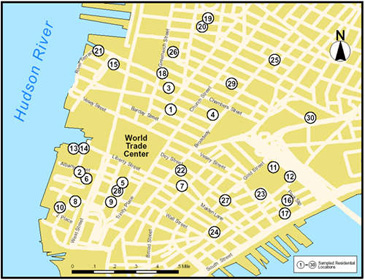|
|
The Agency for Toxic Substances and Disease Registry (ATSDR), a public health service agency in the U.S. Department of Health and Human Services, was created to protect America's health from toxic exposures in the environment.
The mission of ATSDR is to serve the public by using the best science, taking responsive public health actions, and providing trusted health information to prevent harmful exposures and diseases related to toxic substances.
Lower Manhattan Air and Dust Sampling
After the collapse of the World Trade Center towers, the New York City Department of Health and Mental Hygiene and ATSDR collected air and dust samples from 30 residential buildings in November and December 2001 in lower Manhattan. Four buildings in upper Manhattan above 59th Street were also sampled, as a comparison.
The sampling was conducted to find out what hazardous substances were in the air and settled surface dust in those residential areas.
This information was used to find out if hazardous materials in the air and dust were present at levels that could cause harmful health effects and what actions might be needed to protect public health.
The levels of materials detected in the air and dust samples do not pose potential health hazards provided that recommended cleaning measures are followed.
Air Sampling Results
- Airborne levels of total fibers were similar in lower and upper Manhattan.
- Airborne levels of mineral components of concrete and mineral components of building wallboard were higher in lower Manhattan than in the upper Manhattan comparison area.
Settled Surface Dust Sampling Results
- Low levels of asbestos were found in some settled surface dust in lower Manhattan, primarily below Chambers Street.
- No asbestos was found in the upper Manhattan comparison area.
- Lower Manhattan had higher percentages of fiberglass, mineral components of concrete, and mineral components of building wallboard in settled surface dust than the upper Manhattan comparison area.
Public Health Recommendations
- Continue to clean residences with HEPA vacuums and damp cloths/ mops to reduce the potential for exposure, and/or
- Participate in the U.S. Environmental Protection Agency cleaning/sampling program.
Health Implications
Exposure to fiberglass can cause rashes and upper respiratory irritation. However, these health effects diminish and then disappear when the exposure goes away.
Exposure to high levels of asbestos for a long time can cause serious illness. However, the low levels of asbestos detected and the short length of exposure make it very unlikely that people will become ill from that exposure.
Because asbestos and fiberglass particles are in settled dust and can easily become airborne if disturbed, residents should continue to frequently clean their apartments with HEPA vacuums and damp cloths/mops to reduce the potential for exposure.
Understanding the Sampling Results
The levels of particulate matter, airborne irritants, and settled surface dust were likely lower when sampling was conducted (November-December 2001) than they were in the immediate days and weeks after the World Trade Center collapse.
By November, outdoor dust contamination was likely reduced by wind, rain, and cleaning (city workers vacuumed the streets and sidewalks with HEPA trucks). Indoor settled surface dust may have been reduced if areas were cleaned before being sampled.
Therefore, these results probably underestimate the levels of World Trade Center-related materials that were in lower Manhattan immediately after September 11.
Materials Analyzed
We focused on materials that we expected to be present in the original dust cloud and in dust generated by ongoing activities at the World Trade Center, as well as materials that have irritant properties and that are associated with long-term health effects (for example, asbestos and quartz).
The samples were analyzed for the following materials:
- Asbestos
- Fiberglass
- Mineral components of concrete (quartz, calcite, and portlandite)
- Mineral components of building wallboard (gypsum, mica, and halite)
Sampling Dates and Locations
The sampling was conducted from November 4 through December 11, 2001, in and around 30 residential buildings in lower Manhattan.
Four more buildings in upper Manhattan (above 59th Street) were sampled, as a comparison.

Lower Manhattan Air and Dust Sampling Approximate Locations
Follow-Up Activities
The U.S. Environmental Protection Agency (EPA) is currently conducting follow-up activities to address the recommendations.
For more information
- Call the NYC DOHMH hotline at 877-796-5471
- Go to NYC DOHMH's Web site

Contact ATSDR's toll-free information line: (888) 42-ATSDR or (888) 422-8737.
This page last updated on October 30, 2008


